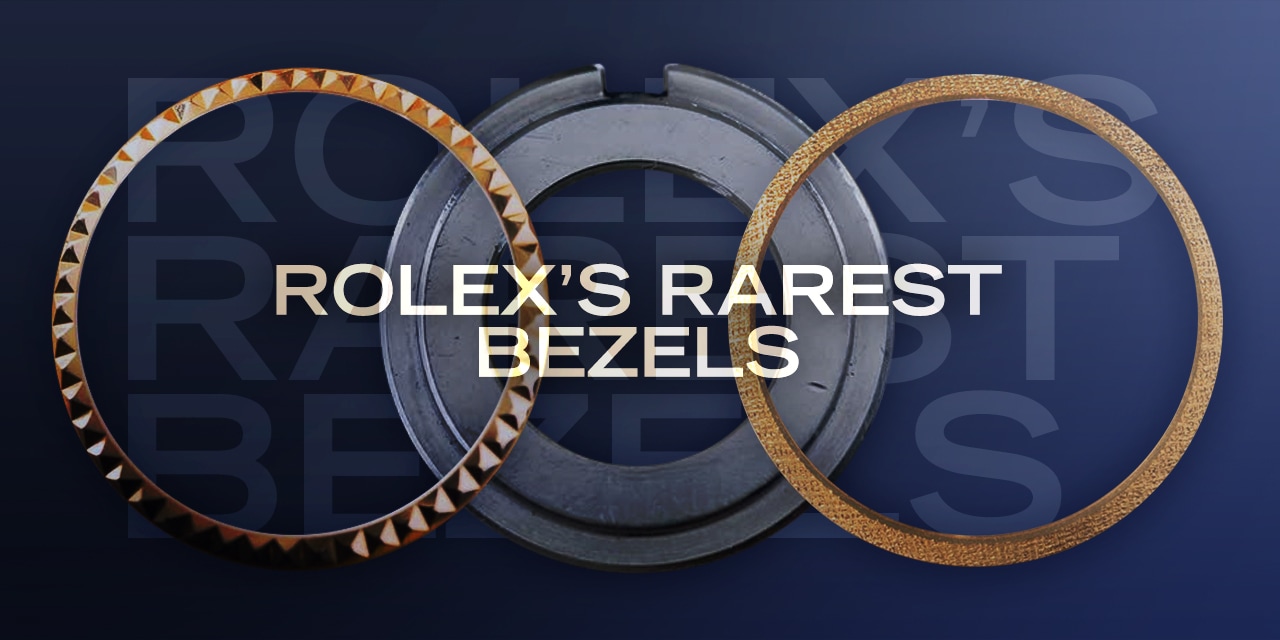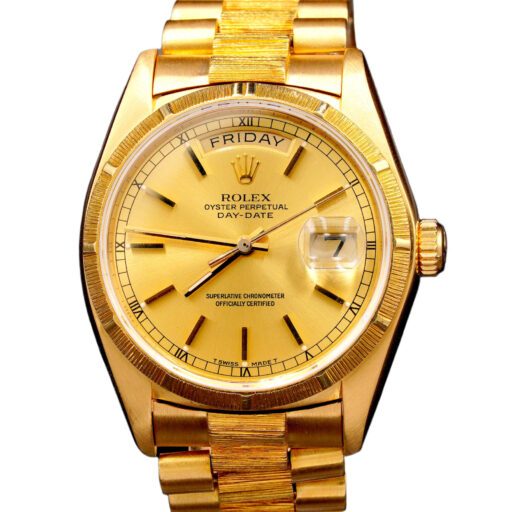Rolex’s Rarest Bezels
If you take a look at the contemporary Rolex collection, you will see a finely honed but relatively uniform set of elements used across the portfolio.
There are, for instance, only four styles of bracelet on offer. There are seven metal types (three of which are 18k gold, just different colors). There are, obviously, a huge number of different dials, but most of the real variety is restricted to only a handful of models (the Datejust and Day-Date, mainly) with much of the Professional Collection restricted to a comparatively small assortment.
Then there are the bezels. These components, vital to the look of any watch, come in half a dozen forms; smooth, fluted, gem-set, rotatable (either uni or bi-directional, or GMT), tachymeter and the Ring Command.
With those constituents, mixed and matched as they see fit, Rolex has created a wealth of diverse watches, each with its own unique identity.
However, it hasn’t always been like that. The streamlined, homogenous entity that is the brand in the modern age is a fairly recent occurrence. In the past, they had to go through a great deal of experimentation to end up where they are now. Many distinct forms of all of these fundamentals came and went, many of them around for little more than the blink of an eye.
And one element which had much more diversity than you might realize is the bezel.
The Rarest Rolex Bezels
You will sometimes read the word ‘rare’ used in a rather loose sense when it comes to Rolex. I’ve seen articles recently which describe the COMEX Subs and Sea-Dwellers as rare; which they are, of course, and yet there never seems to be any shortage of them for sale. Similarly with the original Root Beer GMTs. Sure, there’s not that many of them about—but rare?
Below, we give you a look at bezels which truly qualify for the term, some of which were only used on one reference of one model way back in the far reaches of history!
The Bamboo Bezel
It will come as no surprise at all that many of the surrounds on our list have been given nicknames over the years. And to kick off, there’s the so-called Bamboo bezel.
Produced only from circa. 1959 to 1962, these were a variation on the much missed engine-turned design. Except, instead of including hash marks around the entire surface Bamboo bezels started out smooth and were given an organic, ridged texture at every 10-minute mark which resembled the plant’s stalks.
Exceedingly rare, they were apparently only found on those examples of the Datejust ref. 1603 and Day-Date ref. 1803 fitted with silver dials and alpha handsets.
The Flat-Top Bezel
If you go back to Rolex’s Bubbleback era of the 1930s and ‘40s you will come across myriad weird and wonderful bezel designs.
These come mounted on different case styles, with equally obscure names; Empire, Athlete, Army, King of Wings, etc.
The flat-top bezels were a completely decoration-free surround which differed from the smooth type we are familiar with in that they were not domed.
Today you will be very lucky to find any Rolex models with this sort of bezel, but if you search for references such as the ref. 3595 or the ref. 3135 you might see one.
The Lifesaver Bezel
Taking their name from either the round candy or the shape of an actual life preserver, the Lifesaver bezels were another type fitted to Rolex watches from so long ago they would now be considered antiques rather than just merely vintage.
Their extra wide surface give the watches on which they sit a fairly bizarre look, particularly as they were often used on tiny models of between 29mm and 33mm.
Check out references such as the 32.5mm ref. 2849 or the ‘Disco Volante’ ref. 3190 for two of the more extreme examples, both with a passing resemblance to a scaled-down Omega Alaska Project Speedmaster with its thermal shield intact.
The Creased Bezel
To date, the creased bezel has only been found on one reference; the Bubbleback ref. 3980 produced in the 1940s in very limited numbers.
If you think of a standard domed bezel and then imagine a single ‘pleat’ running through it, it should give you some idea of the look.
The Checkerboard Bezel
This is an interesting one. The Checkerboard bezels were a unique version of the standard engine-turned design, with each of the decorative ridges formed in a square. They were used on the ref. 6305 and ref. 6605 of the Datejust between 1953 and 1959 or thereabouts.
However, if you want a contemporary version, you can see it on Tudor’s current Royal collection.
The Faceted Bezel
Fantastically rare, this type of bezel is identified by its series of triangular faces, such as you might see cut into a gemstone. These, just as they do on a diamond, are designed to catch and reflect the light but were only used by Rolex on one reference; the gold-capped Oyster Perpetual ref. 1025 from the 1960s.
The Scooped Bezel
Scooped bezels are essentially the reverse of domed bezels, in that they curve inwards rather than outwards. The concave bow is very subtle but catches the light nicely and gives a sense of depth to the watch overall. You can sometimes find examples of a scooped bezel on 1940s era Oyster Royal ref. 4444 and ref. 6044 models.
The Scalloped Bezel
Not to be confused with the above, scalloped bezels had a relatively dramatic look.
The large sections cut from the surround provided a great visual feature—very much like the edging on the modern day Omega Seamaster 300’s surround which makes it easier to turn.
Except, on the Rolex references such as the ref. 6286 and ref. 6586 from the ‘50s, the bezels were fixed!
As mentioned earlier, Rolex watches that are now grouped together in the Classic Collection (Datejust, Day-Date, Oyster Perpetual and the like) have long had the most variety when it comes to options, and their bezels are a case in point.
The ones listed below were all found exclusively on these models and almost always in gold.
The Bark Bezel
An extremely seventies-esque aesthetic, Bark bezels were given a texture to resemble tree bark, and usually carried the finish onto the central bracelet links as well.
The Florentine Bezel
The Florentine decoration, consisting of tiny crisscross markings, is unique in that it covered not only the bezel but the entire case and bracelet as well. You will find it used most on the President ref. 1806 made throughout the 1960-70s.
The Zephyr Bezel
Unlike the other examples on our list, ‘Zephyr’ as it applies to Rolex denotes both bezel and dial.
It was used only on Oyster Perpetual and Oyster Perpetual Date watches sold in the U.S., starting with the ref. 6582 in the mid-1950s.
A distinctive design, and one borrowed from Omega, the dial featured a crosshair motif splitting it into quarters, while the bezel came in two types. Both variations on the engine-turned bezel, one had regularly spaced straight lines while the other was given triangular points at the five-minute marks.
The Morellis Bezel
Incredibly ornate, the Morellis design, a bit like the Florentine, featured on the bracelet as well as the bezel of certain Oyster Perpetual Date watches, although not the cases. The Morellis looks a little like a gold foil candy wrapper scrunched up then straightened out and, interestingly, is more often than not found on watches with a Zephyr dial.
The Jute Bezel
The name here is something of a giveaway. Jute bezels have a look much like the natural fiber used to make burlap bags.
The Chine Bezel
A particularly busy design, the Chine bezel has a series of random slashes engraved into the surface.
The Pyramid Bezel
Rolex’s tepid venture into the world of quartz threw out a host of unorthodox bezel styles, particularly on the Oysterquartz Day-Date.
Pyramids seemed to be ‘in’ at Rolex during much of the time as well, and references like the ref. 19028 and ref. 19038 both featured them on both bezels and bracelets.
But there was also an exceptionally rare automatic President with a pyramid bezel too, the ref. 18018.
The Piranha Bezel
Perhaps the rarest of the lot, the Piranha bezel has only been found on a single watch, a Datejust ref. 1605 from around 1960.
Again, not difficult to see how it got its name; the grooves etched into the surround look like row after row of tiny, viciously sharp teeth.
That’s our rundown of some of the rarest Rolex bezels. There are, of course, many many more we didn’t have space to fit in.
In our next article, we’ll trace some of Rolex’s rarest dials.
Featured Photo: BeckerTime’s Archive.







